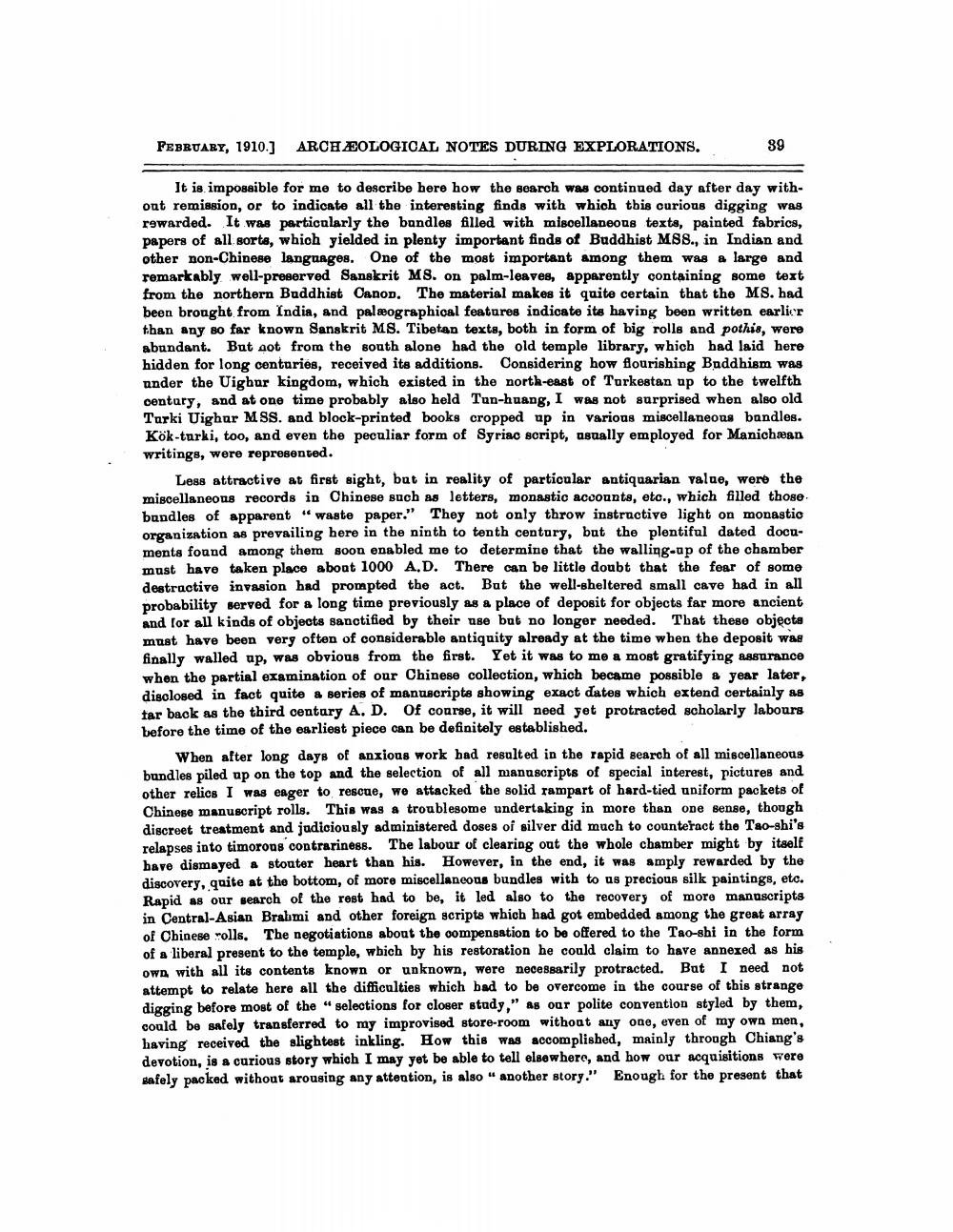________________
FEBRUARY, 1910.] ARCHEOLOGICAL NOTES DURING EXPLORATIONS.
89
It is impossible for me to describe here how the search was continued day after day without remission, or to indicate all the interesting finds with which this curious digging was rewarded. It was particularly the bundles filled with miscellaneous texts, painted fabrics, papers of all sorts, which yielded in plenty important finds of Buddhist MSS., in Indian and other non-Chinese languages. One of the most important among them was a large and remarkably well-preserved Sanskrit MS. on palm-leaves, apparently containing some text from the northern Buddhist Canon. The material makes it quite certain that the MS. had been brought from India, and palæographical features indicate its having been written earlier than any so far known Sanskrit MS. Tibetan texts, both in form of big rolls and pothis, were abundant. But not from the south alone had the old temple library, which had laid here hidden for long centuries, received its additions. Considering how flourishing Buddhism was under the Uighur kingdom, which existed in the north-east of Turkestan up to the twelfth century, and at one time probably also held Tun-huang, I was not surprised when also old Turki Uighur MSS. and block-printed books cropped up in various miscellaneous bandles. Kök-turki, too, and even the peculiar form of Syriac script, usually employed for Manichæan writings, were represented.
Less attractive at first sight, but in reality of particular antiquarian value, were the miscellaneous records in Chinese such as letters, monastic accounts, etc., which filled those bundles of apparent "waste paper." They not only throw instructive light on monastic organization as prevailing here in the ninth to tenth century, but the plentiful dated documents found among them soon enabled me to determine that the walling-up of the chamber must have taken place about 1000 A.D. There can be little doubt that the fear of some destructive invasion had prompted the act. But the well-sheltered small cave had in all probability served for a long time previously as a place of deposit for objects far more ancient and for all kinds of objects sanctified by their use but no longer needed. That these objects must have been very often of considerable antiquity already at the time when the deposit was finally walled up, was obvious from the first. Yet it was to me a most gratifying assurance when the partial examination of our Chinese collection, which became possible a year later, disclosed in fact quite a series of manuscripts showing exact dates which extend certainly as tar back as the third century A. D. Of course, it will need yet protracted scholarly labours before the time of the earliest piece can be definitely established.
When after long days of anxious work had resulted in the rapid search of all miscellaneous bundles piled up on the top and the selection of all manuscripts of special interest, pictures and other relics I was eager to rescue, we attacked the solid rampart of hard-tied uniform packets of Chinese manuscript rolls. This was a troublesome undertaking in more than one sense, though discreet treatment and judiciously administered doses of silver did much to counteract the Tao-shi's relapses into timorons contrariness. The labour of clearing out the whole chamber might by itself have dismayed a stouter heart than his. However, in the end, it was amply rewarded by the discovery, quite at the bottom, of more miscellaneous bundles with to us precious silk paintings, etc. Rapid as our search of the rest had to be, it led also to the recovery of more manuscripts in Central-Asian Brahmi and other foreign scripts which had got embedded among the great array of Chinese rolls. The negotiations about the compensation to be offered to the Tao-shi in the form of a liberal present to the temple, which by his restoration he could claim to have annexed as his own with all its contents known or unknown, were necessarily protracted. But I need not attempt to relate here all the difficulties which had to be overcome in the course of this strange digging before most of the "selections for closer study," as our polite convention styled by them, could be safely transferred to my improvised store-room without any one, even of my own men, having received the slightest inkling. How this was accomplished, mainly through Chiang's devotion, is a curious story which I may yet be able to tell elsewhere, and how our acquisitions were safely packed without arousing any attention, is also " another story." Enough for the present that




